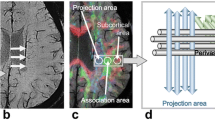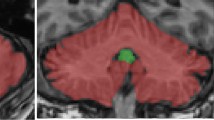Abstract
Round granulated body (RGB) and eosinophilic hyaline droplets (EHDs) have been described as cytoplasmic inclusions of certain astrocytic tumors. In the previous literature, however, these inclusions have been described using various terms or regarded as nosologically the same entity. Light microscopically, RGB apeared as a round discrete body filled with fine uniform granules, while EHDs demonstrated a cluster of bright eosinophilic, round objects of various size. They could be clearly distinguished even by conventional histochemical staining such as the Masson trichrome stain and the phosphotungstic acid hematoxylin preparation. Both RGB and EHDs expressed positive immunoreactions for glial fibrillary acidic protein, several lysosomal markers, and some stress-response proteins. The ultrastructural appearances of these inclusions were distinct, however, one common feature was that they consisted of aggregations of numerous membrane-bound electron-dense bodies. Thus, both inclusions appear to be produced by neoplastic astrocytes and are possibly related to the lysosomal system. We examined the presence of RGB and EHDs in 138 astrocytic tumors. Both inclusions occurred most frequently in pleomorphic xanthoastrocytomas, followed by gangliogliomas and pilocytic astrocytomas. Subependymal giant cell astrocytomas exhibited only RGBs. RGBs and EHDs were not seen in any abundance in glioblastomas, gliosarcomas, fibrillary astrocytomas, protoplasmic astrocytomas, or oligo-astrocytomas. Some glioblastomas, however, showed only EHDs in small numbers. Several anaplastic astrocytomas were associated with a large number of RGBs and/or EHDs, and they revealed only rare mitosis despite marked cellular pleomorphism. Although RGB and EHDs have different morphological features, the presence of these inclusions in abundance may represent either a degenerative change, a long-standing lesion, or an indolent growth of the astrocytic tumors.
Similar content being viewed by others
References
Allegranza A, Ferraresi S, Bruzzone M, Giombini S (1991) Cerebromeningeal pleomorphic xanthoastrocytoma. Report of four cases: clinical, radiological and pathological features (including a case with malignant evolution). Neurosurg Rev 14: 43–49
Arai N, Yagishita S, Amano N, Iwabuchi K, Misugi K (1989) “Grumose degeneration” of Tretiakoff. J Neurol Sci 94: 319–323
Arai N, Yagishita S, Misugi K, Oda M, Kosaka K, Mizutani T, Morimatsu Y (1992) Peculiar axonal debris with subsequent astrocytic response (foamy spheroid body). A topographic, light microscopic, immunohistochemical and electron microscopic study. Virchows Arch [A] 420: 243–252
Arai N, Mizutani T, Morimatsu Y (1993) Foamy spheroid bodies in the globus pallidus and the substantia nigra pars reticulata: an investigation on regional distribution in 56 cases without neurodegenerative diseases. Virchows Arch [A] 422: 307–311
Barnard RO, Scott T (1980) A note on the nature of eosinophilic granular bodies in astrocytic gliomas. Acta Neuropathol (Berl) 50: 245–247
Brett M, Weller RO (1978) Intracellular serum proteins in cerebral gliomas and metastatic tumors. Neuropathol Appl Neurobiol 4: 263–272
Burger PC, Scheithauer BW, Vogel FS (1991) Surgical pathology of the nervous system and its coverings, 3rd edn. Churchill Livingstone, New York
Caine GD, Weller RO, Davis BE, Cox S (1980) Mechanisms of uptake and the fate of serum proteins and HRP in cultured human glioma cells. Acta Neuropathol (Berl) 52: 167–177
Dekker A, Krause JR (1973) Hyaline globules in human neoplasms. Arch Pathol 95: 178–181
Dickson DW, Suzuki KI, Kanner R, Weitz S, Horoupian DS (1986) Cerebral granular cell tumor: immunohistochemical and electron microscopic study. J Neuropathol Exp Neurol 45: 304–314
Doherty FJ, Osborn NU, Wassell JA, Heggie PE, Laszlo L, Mayer RJ (1989) Ubiquitin-protein conjugates accumulate in the lysosomal system of fibroblasts treated with cysteine proteinase inhibitors. Biochem J 263: 47–55
Ellis RJ, van der Vies SM (1991) Molecular chaperones. Annu Rev Biochem 60: 321–347
Galloway PG, Likavec MJ (1989) Ubiquitin in normal, reactive and neoplastic human astrocytes. Brain Res 500: 343–351
Goldman JE, Chin FC (1984) Growth kinetics, cell shape, and cytoskeleton of primary astrocyte cultures. J Neurochem 42: 175–184
Iwaki T, Fukui M, Kondo A, Takeshita I (1987) Epithelial properties of pleomorphic xanthoastrocytomas determined in ultrastructural and immunohistochemical studies. Acta Neuropathol (Berl) 74: 142–150
Iwaki T, Kume-Iwaki A, Liem RKH, Goldman JE (1989) αB-crystallin is expressed in non-Jenticular tissues and accumulations in Alexander's disease brain. Cell 57: 71–78
Iwaki T, Kume-Iwaki A, Goldman JE (1990) αB-crystallin in non-lenticular tissues. J Histochem Cytochem 38: 31–39
Iwaki T, Iwaki A, Miyazono M, Goldman JE (1991) Preferential expression of αB-crystallin in astrocytic elements of neuroectodermal tumors. Cancer 68: 2230–2240
Iwaki T, Wisniewski T, Iwaki A, Corbin E, Tomokane N, Tateishi J, Goldman JE (1992) Accumulation of αB-crystallin in central nervous system glia and neurons in pathologic conditions. Am J Pathol 140: 345–356
Iwaki T, Iwaki A, Tateishi J, Sakaki Y, Goldman JE (1993) αB-crystallin and 27-kDa heat shock protein are regulated by stress conditions in the central nervous system and accumulate in Rosenthal fibers. Am J Pathol 143: 487–495
Kawano N (1992) Pleomorphic xanthoastrocytoma: some new observations. Clin Neuropathol 11: 323–328
Kepes JJ, Rubinstein LJ, Eng LF (1979) Pleomorphic xanthoastrocytoma; a distinctive meningocerebral glioma of young subjects with relatively favorable prognosis. A study of 12 cases. Cancer 44: 1839–1852
Kepes JJ, Rubinstein LJ, Ansbacher L, Schreiber DJ (1989) Histopathological features of recurrent pleomorphic xanthoastrocytomas: further corrboration of the glial nature of this neoplasm. A study of 3 cases. Acta Neuropathol 78: 585–593
Kleihues P, Burger PC, Scheithauer BW (1993) Histological typing of tumours of the central nervous system, 2nd edn. Springer, Berlin Heidelberg New York
Kornfeldt M (1986) Granular cell glioblastoma: a malignant granular cell neoplasm of astrocytic origin. J Neuropathol Exp Neurol 45: 447–462
Kros JM, Vecht CJ, Stefanko SZ (1991) The pleomorphic xanthoastrocytoma and its differential diagnosis: a study of five cases. Hum Pathol 22: 1128–1135
Kusaka H, Hirano A, Bornstein MB, Moore GRW, Raine CS (1986) Transformation of cells of astrocyte lineage into macrophage-like cells in organotypic cultures of mouse spinal cord tissue. J Neurol Sci 72: 77–89
Lowe J, Blanchard A, Morrell K, Lennox G, Reynolds L, Billett M, Landon M, Mayer RJ (1988) Ubiquitin ia a common factor in intermediate filament inclusion bodies of diverse type in man, including those of Parkinson's disease, Pick's disease, and Alzheimer's disease, as well as Rosenthal fibres in cerebellar astrocytomas, cytoplasmic bodies in muscle, and Mallory bodies in alcoholic liver disease. J Pathol 155: 9–15
Manetto V, Abdul-Karim FW, Perry G, Tabaton M, Autilio-Gambetti L, Gambetti P (1989) Selective presence of ubiquitin in intracellular inclusions. Am J Pathol 134: 505–513
Mayer RJ, Lowe J, Landon M (1991) Ubiquitin and the lysosomal system: molecular immunopathology reveals the connection. Biomed Biochim Acta 50: 333–341
Miyazono M, Iwaki T, Kitamoto T, Shin RW, Fukui M, Tateishi J (1993) Widespread distribution of tau in the astrocytic elements of glial tumors. Acta Neuropathol 86: 236–241
Murayama S, Bouldin TW, Suzuki K (1992) Immunocytochemical and ultrastructural studies of eosinophilic granular bodies in astrocytic tumors. Acta Neuropathol 83: 408–414
Ng H-K, Lo STH (1988) Immunostaining for α1-antichymotrypsin and α1-antitrypsin in gliomas. Histopathology 13: 79–87
Rubinstein LJ, Herman MM (1972) A light- and electron-microscopic study of a temporal-lobe ganglioglioma. J Neurol Sci 16: 27–48
Russell DS, Rubinstein LJ (1971) Pathology of tumours of the nervous system, 3rd edn. Arnold, London
Russell DS, Rubinstein LJ (1989) Pathology of tumours of the nervous system, 5th edn. Arnold, London
Sawa H, Takeshita I, Kuramitsu M, Mannoji H, Machi T, Fukui M, Kitamura K (1986) Neuronal and glial proteins in medulloblastomas. Immunohistochemical study. Anticancer Res 6: 905–910
Shin R-W, Ogomori K, Kitamoto T, Tateishi J (1989) Increased tau accumulation in senile plaques as a hallmark in Alzheimer's disease. Am J Pathol 134: 1365–1371
Shin RW, Iwaki T, Kitamoto T, Tateishi J (1991) Hydrated autoclave pretreatment enhances tau immunoreactivity in formalin-fixed normal and Alzheimer's disease brain tissues. Lab Invest 64: 693–702
Smith DA, Lantos PL (1985) Immunocytochemistry of cerebellar astrocytomas: with a special note on Rosenthal fibres. Acta Neuropathol 66: 155–159
Snipes GJ, Horoupian DS, Shuer LM, Silverberg GD (1992) Pleomorphic granular cell astrocytoma of the pineal gland. Cancer 70: 2159–2165
Whittle IR, Gordon A, Misra BK, Shaw JF, Steers JW (1989) Pleomorphic xanthoastrocytoma, report of four cases. J Neurosurg 70: 463–468
Yamada T, McGeer PL, McGeer EG (1992) Appearance of paired nucleated, tau-positive glia in patients with progressive supranuclear palsy brain tissue. Neurosci Lett 135: 99–102
Zorzi F, Facchetti F, Baronchelli C, Cani E (1992) Pleomorphic xanthoastrocytoma: an immunohistochemical study of 3 cases. Histopathology 20: 267–269
Zuccarello M, Sawaya R, Ray BM (1987) Immunohistochemical demonstration of alpha-1-proteinase inhibitor in brain tumors. Cancer 60: 804–809
Zülch KJ (1959) Das Glioblastom, morphologisch und biologisch gesehen. Acta Neurochir (Wien) [Suppl] 6: 2–30
Zülch KJ (1986) Brain tumours. Their biology and pathology, 3rd edn. Springer, Berlin Heidelberg New York
Author information
Authors and Affiliations
Rights and permissions
About this article
Cite this article
Hitotsumatsu, T., Iwaki, T., Fukui, M. et al. Cytoplasmic inclusions of astrocytic elements of glial tumors: special reference to round granulated body and eosinophilic hyaline droplets. Acta Neuropathol 88, 501–510 (1994). https://doi.org/10.1007/BF00296486
Received:
Accepted:
Issue Date:
DOI: https://doi.org/10.1007/BF00296486




